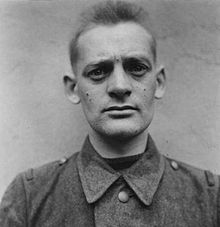Kleinbodungen subcamp
The Kleinbodungen subcamp was a subcamp of the Mittelbau concentration camp that existed from October 3, 1944 to April 4, 1945 for an average of around 620 male concentration camp prisoners . It was located on the site of a former potash mine in Kleinbodungen . The subcamp was run by the camp SS under the cover name "Emmi".
Function of the camp, inmates and camp management
The prisoners, most of whom came from the closed Friedrichshafen satellite camp of the Dachau concentration camp after the camp was set up , were housed in two warehouses, each with three floors. The camp area was fenced off with electrically charged barbed wire. The prisoners did forced labor for Mittelwerk GmbH and had to dismantle defective A4 rockets into their individual parts in the camp's own rocket workshop, some of which were reused for newly produced rockets. In addition, defective A4 missiles were stored on the site with the Reichsbahn connection . An air raid at the beginning of January 1945 caused damage, but the missile repair workshop remained functional.
Kleinbodungen was the camp with the highest proportion of Reich German prisoners among all the Mittelbau camps . About a fifth of the prisoners were Reich Germans, a third each from Poland or the Soviet Union and the rest of other nationalities. The camp leader was SS-Hauptscharführer Xaver strengfel , his deputy SS-Oberscharführer Wilhelm Dörr .
Branches in Bischofferode and Niedergebra
From the beginning of November 1944, branches of the Kleinbodungen subcamp were located with 60 male prisoners in Bischofferode / Eichsfeld ("Command 48") and around 40 male prisoners in Niedergebra ("Command 48a"). The prisoners in these satellite camps were also used to repair and store defective A4 rockets from Mittelwerk GmbH. These external commands were evacuated together with the inmates of the Kleinbodungen satellite camp on April 4 and 5, 1945, respectively.
Evacuation of the camp
In the course of the evacuation of the Mittelbau concentration camp, the prisoners of the Kleinbodungen satellite camp were also sent on a death march on April 4 or 5, 1945 . On April 4, 1945, according to his testimony, Strongfel received an order from the camp leader Franz Hössler to evacuate the Kleinbodungen satellite camp. On April 5, 1945, 610 prisoners and 45 SS men left Kleinbodungen on a death march under his leadership and that of his deputy Wilhelm Dorr . Originally the order from Herzberg was to transport the prisoners by train. Due to air strikes, Stofel decided to march the prisoners to the Bergen-Belsen concentration camp . On April 10, 1945, after some prisoners had already managed to escape, the evacuation transport ended up in a combat zone near Groß Hehlen north of Celle. During the fighting, some prisoners were shot by field units because they attempted to escape and the march was too slow. On April 11, 1945, the evacuation transport arrived at the Bergen-Belsen concentration camp with 590 prisoners.
Liberation of the prisoners and the post-war period
On April 15, 1945, the Bergen-Belsen concentration camp was liberated. Nothing is known about the number of deceased prisoners in the Kleinbodungen subcamp. Stark and Dörr received the death sentence in the Bergen-Belsen trial for their responsibility for the death march. The sentence was carried out on December 13, 1945 by hanging in Hameln prison .
After the Americans handed Thuringia over to the Soviet military administration on July 1, 1945 , the remaining machines and material from the Kleinbodungen satellite camp were dismantled and taken to the Soviet Union in October 1946 . Arrested German engineers reconstructed the A4 in the Kleinbodungen and Bleicherode satellite camps as early as the summer of 1945 on behalf of the Soviet authorities. In the present, only a workshop used as a grain store reminds of the former Kleinbodungen external warehouse.
literature
- Andrè Sellier: Forced labor in the rocket tunnel - history of the Dora camp , zu Klampen, Lüneburg 2000, ISBN 3-924245-95-9 .
- Jens-Christian Wagner (ed.): Mittelbau-Dora Concentration Camp 1943-1945 Accompanying volume for the permanent exhibition in the Mittelbau-Dora Concentration Camp Memorial. Wallstein, Göttingen 2007, ISBN 978-3-8353-0118-4 .
- Jens Christian Wagner: Kleinbodungen sub-camp. In: Wolfgang Benz , Barbara Distel (eds.): The place of terror . History of the National Socialist Concentration Camps. Volume 7: Niederhagen / Wewelsburg, Lublin-Majdanek, Arbeitsdorf, Herzogenbusch (Vught), Bergen-Belsen, Mittelbau-Dora. CH Beck, Munich 2008, ISBN 978-3-406-52967-2 .
- Frank Baranowski: The suppressed past. Arms production and forced labor in Northern Thuringia , Mecke Verlag, Duderstadt 2000, p. 110 ff., ISBN 978-3-932752-67-4 .
- Jens-Christian Wagner: Production of death: The Mittelbau-Dora concentration camp , Wallstein Verlag, Göttingen 2001, ISBN 3-89244-439-0 .
Individual evidence
- ↑ Jens-Christian Wagner (ed.): Mittelbau-Dora concentration camp 1943-1945 , Göttingen 2007, p. 193.
- ↑ a b c d e Jens Christian Wagner: Kleinbodungen satellite camp. In: Wolfgang Benz , Barbara Distel (eds.): The Place of Terror - History of the National Socialist Concentration Camps , Volume 7, Munich 2008, pp. 316f.
- ^ Andrè Sellier: Forced Labor in the Rocket Tunnel - History of the Dora Camp , Lüneburg 2000, p. 183f.
- ^ Jens Christian Wagner: Niedergebra subcamp ("Command 48a") and Bischofferode / Eichsfeld subcamp. In: Wolfgang Benz, Barbara Distel (eds.): The Place of Terror - History of the National Socialist Concentration Camps , Volume 7, Munich 2008, pp. 293, 319
- ↑ a b Statement by Xaver Starke in the Bergen-Belsen trial on October 23, 1945 at www.mazal.org
- ^ Andrè Sellier: Forced Labor in the Rocket Tunnel - History of the Dora Camp , Lüneburg 2000, p. 395.
Coordinates: 51 ° 27 ′ 51 ″ N , 10 ° 32 ′ 2 ″ E

